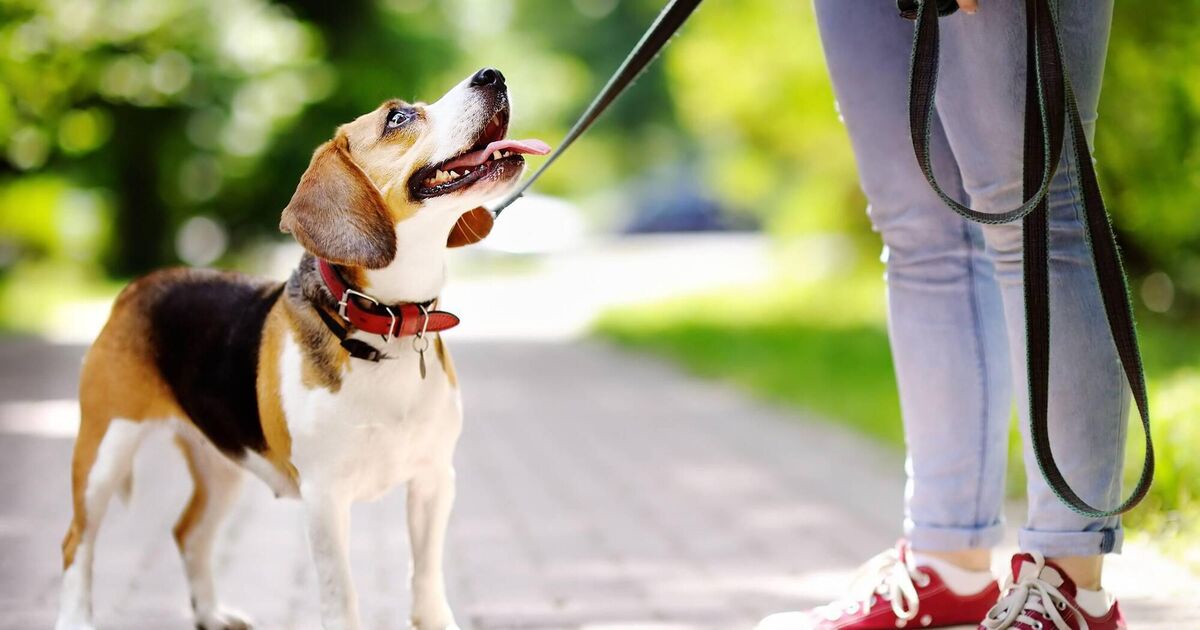Slip leads, which are also referred to as slip leashes, are dog leashes that can be easily slipped on and off. As the name suggests, these leashes consist of a loop handle and a second loop at the other end designed to encircle the dog's neck.
To place the slip lead around the dog's neck, the loop can be opened widely. Once the loop is in position, pulling on the leash will cause the loop to tighten, fitting snugly around the dog's neck and preventing it from slipping off.
It is important to have a stopper on the slip lead to prevent the loop from opening too widely and causing it to slip off the dog's head. After placing the loop around the dog's neck, sliding the stopper in place helps to secure the leash and prevent the dog from backing out. Ideally, there should be enough space to fit 2-3 fingers between the loop and the dog's neck.
Slip leads can be made from a variety of materials, with nylon being the most common. Leather is another popular option. British-style slip leads are often constructed from thick rope with a leather tab serving as the stopper.
In summary, this provides a comprehensive overview of slip leads for dogs. It can be described as a combination of a lead and collar, rather than a stand-alone lead.
One key distinction that sets a slip lead apart from a regular lead is that it does not attach to a collar with a snap hook, as there is no collar involved.
Advantages of Slip Leads:
Slip leads for dogs offer several advantages that make them a convenient choice for specific applications. Below, we will explore some common uses of slip leads for dogs.
Ease of Use
Slip leads are a popular choice among shelters and rescues due to their simple and easy-to-use design. These organizations often encounter dogs with unknown backgrounds, fearfulness, or reactivity who may not tolerate close contact around their face.
Dealing with such dogs requires avoiding risky actions like bending down near their face, fumbling with a collar, and loudly snapping a leash. In such cases, slip leads can be incredibly useful.
A common technique is to distract the dog with a long-handled wooden spoon smeared with peanut butter while slipping the lead over their head. This way, the dog can be quickly and safely controlled.
Slip leads also prove helpful in retrieving dogs from enclosures. With one hand holding the door slightly open, a handler can use the other to slip the lead over the dog's head as they eagerly try to exit. Once the lead is in place, the door can be opened wider to allow the dog to leave.
For particularly difficult-to-control dogs, two handlers may use slip leads on either side of the dog for greater control.
Efficient Movement of Dogs
Slip leads are a fast and safe method of quickly controlling a dog, making them ideal for getting dogs in and out of vehicles and kennels without invading their personal space.
This feature makes slip leads a popular tool among shelters, rescues, and veterinary offices. During my time at a vet's office, we had many slip leads hanging nearby, and I always carried one over my shoulder for immediate use.
Slip leads are also popular among owners of dogs involved in agility competitions or fieldwork, as they can be easily and quickly slipped on and replaced.
Frequently Utilized in Dog Shows
Slip leads are frequently used in dog shows, but only with dogs that have been acclimated to being in the presence of high levels of distractions from a young age and have undergone extensive training.
The use of slip leads in dog shows serves to enhance the dogs' appearance and allows handlers to exhibit their dogs with minimal interference. Typically, a more subtle and less conspicuous slip lead is employed for dogs that are being showcased.
Beneficial for Training
Using a slip lead can also aid in training dogs to walk calmly on a leash. The underlying principle is simple: whenever your dog tugs, the loop tightens around their neck, creating an unpleasant sensation. This technique is similar to using a choke chain, but a slip lead is typically made of nylon or rope instead of chain.
Over time, the dog should learn that pulling causes discomfort, and thus, the pulling should decrease with training. However, it is vital to read further about the negative effects of these leads, as discussed in the disadvantages section below.
When evaluating slip leads for dogs, it's essential to consider their cons. Some of these issues may lead one to question the use of this equipment, especially given the availability of less aversive alternatives.
Disadvantages of Slip Leads:
There are several drawbacks to using slip leads for dogs. These drawbacks raise questions about the value of using this type of equipment, considering that there are many less aversive alternatives.
Aversion-Based Training Tool
Like choke collars, prong collars, and shock collars, slip leads work by creating unpleasant sensations in the dog. It is an aversion-based tool that operates through positive punishment and negative reinforcement. These types of tools can lead to several problems.
Positive Punishment
A slip lead works through positive punishment when the owner jerks the leash to deliver a correction when the dog performs an undesirable behavior on walks. The dog feels an unpleasant sensation of the loop tightening around the neck, which over time should reduce the undesirable behavior (punishment). The assumption is that the owner's timing is right and the dog is not over threshold.
Negative Reinforcement
A slip lead works through negative reinforcement when the dog starts pulling ahead, and the loop tightens around the neck, causing an unpleasant sensation. Over time, the dog learns that when walking next to the owner, the loop no longer tightens, and the unpleasant sensation is removed (negative). The behavior of walking near the owner without pulling should increase (reinforcement), assuming that the dog is not over threshold and that approaching other things on walks does not override the unpleasant sensation.
Risks of Negative Associations
When a slip lead is used to train a dog to walk on a leash, the dog learns to associate natural behaviors, such as sniffing or trying to greet a person or dog, with an uncomfortable neck-tightening sensation. However, there are risks that the dog may associate anything they see, hear, or feel at the moment with the unpleasant sensation. This means that the dog may even associate the unpleasant sensation with the owner. Research has shown that dogs can associate receiving shocks with their owners or their commands, even outside of the normal training context.
Risks of Choking and Gagging
Many dogs are excited about going on walks and their excitement to pull and sniff or get closer to people or other exciting stimuli can override the unpleasant strangulation-type sensation of the loop. The same goes for dogs that are fearful and reactive. Their fight or flight responses kick in, causing them to be too over threshold to cognitively function and learn polite leash walking. Additionally, the unpleasant sensation may cause them to become more anxious or reactive, leading to dogs that keep pulling despite the tightening effect, causing them to gag, cough, and make choking sounds on walks.
Risks of Damage to Delicate Structures
A lead tightening around a dog's neck may not seem like a big deal, but a dog's epidermis is only 3-5 cells thick, while a human's is at least 10-15 cells thick. Under the neck area, several delicate structures, such as the larynx, thyroid gland, arteries, and several nerves, are hidden. Excessive pressure can cause damage to the dog's eyes, larynx, and thyroid gland.


No comments yet